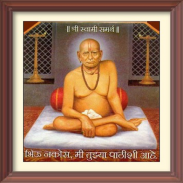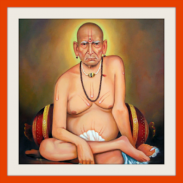




Shri Swami Mala Mantra श्री स्वामी माला मंत्र
Hindu Devi Devta Apps
Descrizione di Shri Swami Mala Mantra श्री स्वामी माला मंत्र
Shri Swami Samarth Mantras | OFFLINE | HD Audio | Repeat | FREE | HD God image
Swāmi Samarth Mahāraj more commonly Shri Swami Samarth Maharaj (also known as Akkalkot Swāmi Mahāraj) of Akkalkot (left the physical body in 1878). He was also lovingly referred to as Swami Samartha or Akkalkot Maharaj by his devotees.[3][4] was an Indian Guru of the Dattatreya tradition (sampradaya), widely respected in indian states of Maharashtra,[5] as well as in Karnataka and Andhra Pradesh with Shripad Shri Vallabha and Narasimha Saraswati. His existence in physical form is dated in the nineteenth century AD.
Shri Swami Samarth traveled all over the country and eventually set his abode at Akkalkot village in Maharashtra, India. Maharaj first appeared at Akkalkot on a Wednesday around the September–October period in the year 1856 AD near Khandoba Mandir. He stayed in Akkalkot for close to twenty-two years. His parentage & native place details remain obscure to this day. Once when a devotee posed him a question about his life Shri Swami Samarth indicated that he is the origin of the Banyan tree (Vata- Vriksha). On another occasion Swami said that his name was Nrusimha Bhan and that he was from Kardalivan near Srisailam
The description of Shri Swami Samarth's appearance has been based on the vivid descriptions given by close devotees. Though he was seen at an advanced age, his skin was not wrinkled. He was very tall and his hands were long, extending down to his knees. His belly was protruding and he had broad shoulders. His complexion was fair and pinkish. He had big ears with thin and long ear-lobes which shook with the slightest movement of his body. He had long feet. He adorned a sacred mark (thilakam) on his forehead. He always wore a codpiece (kaupina). He had a fine set of teeth and a big and deep navel. He always wore a tulasi-rosary (which is very different from rudraksha) and a crystal (sphatika). He had ear-rings inset with gems.
* The Siddha Mantra of Shri Swami Samarth is: SHRI SWAMI SAMARTH (Marathi: श्री स्वामी समर्थ )
* The biography of Shrivallabh is in the Shripada Shrivallabha Charitramrut
* The biography of Nrusimha Saraswati is in the Gurucharitra.
* The biography of Shri Swami Samarth is in the Guruleelamrut.
In the month of Chaitra (April–May) in 1878, the thirteenth day of the dark-half of the lunar month. Swami Maharaj lived mainly at the residence of his disciple Cholappa, where his shrine is now located.
As such Swami can not undergo death like ordinary people[citation needed]. It is believed that, he is in existence before beginning of the universe and will exist after destruction of the universe. Swami can not disappear suddenly in front of people and he performed a rite known as Samadhi, which has death like effect but not an actual death. Swami is for perpetuity.
Anant Koti Brahmand Dayak Gajanan अनंत कोटि ब्रह्माण्ड दायक गजानन
Swaminche Sahasranam स्वामींचे सहस्रनाम
Shri Swami Samarth Taarak Mantra श्री स्वामी समर्थ तारक मंत्र
Om Namoh Shree Gajanan ॐ नमः श्री गजानन
Shree Swami Samarth Charitra श्री स्वामी समर्थ चरित्र
Swami Samartha Jaap 108 times स्वामी समर्थ जाप १०८ बार
A Beautiful Swami Stavan स्वामी स्तवन
Swami Samarth Mahamantra स्वामी समर्थ महामंत्र
Shri Swami Mala Mantra श्री स्वामी माला मंत्र
Shri Swami Samarth Dhun श्री स्वामी समर्थ धुन
Shri Swami Samarth Mantras | ASSENTE | HD Audio | ripetere | GRATIS | a immagine di Dio HD
SWAMI Samarth maharaj più comunemente Shri Swami Maharaj Samarth (noto anche come Akkalkot Swāmi Mahāraj) di Akkalkot (lasciato il corpo fisico nel 1878). E 'stato anche amorevolmente chiamato Swami Samartha o Akkalkot Maharaj dai suoi devoti. [3] [4] era un guru indiano della tradizione Dattatreya (sampradaya), ampiamente rispettato in stati indiani del Maharashtra, [5] così come in Karnataka e Andhra Pradesh con Shripad Shri Vallabha e Narasimha Saraswati. La sua esistenza in forma fisica è datato nel XIX secolo dC.
Shri Swami Samarth viaggiato in tutto il paese e, infine fissato la sua dimora nel villaggio Akkalkot nel Maharashtra, in India. Maharaj prima apparizione in Akkalkot di Mercoledì intorno al periodo di settembre-ottobre del 1856 dC vicino Khandoba Mandir. Rimase a Akkalkot per vicino a ventidue anni. Sua discendenza e luogo natale dettagli restano oscuri fino ad oggi. Una volta, quando un devoto gli ha posto una domanda sulla sua vita Shri Swami Samarth ha indicato che è l'origine dell'albero Banyan (vata Vriksha). In un'altra occasione, Swami ha detto che il suo nome era Nrusimha Bhan e che era da Kardalivan vicino Srisailam
La descrizione della comparsa di Shri Swami Samarth è stata basata sulle descrizioni vivide fornite dal vicino devoti. Anche se è stato visto in età avanzata, la sua pelle non era rugosa. Era molto alto e le sue mani erano lunghe, che si estende fino alle ginocchia. La sua pancia era sporgente e aveva le spalle larghe. La sua carnagione era giusto e rosato. Aveva grandi orecchie con sottili e lunghi lobi delle orecchie che hanno scosso con il minimo movimento del suo corpo. Aveva lunghi piedi. Egli adorna un segno sacro (thilakam) sulla fronte. Indossava sempre una braghetta (kaupina). Aveva una bella serie di denti e un grande e profondo ombelico. Portava sempre un tulasi-rosario (che è molto diverso da rudraksha) e un cristallo (sphatika). Aveva orecchini incastonate di gemme.
* Il Siddha Mantra di Shri Swami Samarth è: Shri Swami Samarth (Marathi: श्री स्वामी समर्थ)
* La biografia di Shrivallabh è nella Shripada Shrivallabha Charitramrut
* La biografia di Nrusimha Saraswati è nel Gurucharitra.
* La biografia di Shri Swami Samarth è nel Guruleelamrut.
Nel mese di Chaitra (aprile-maggio) nel 1878, il tredicesimo giorno del buio metà del mese lunare. Swami Maharaj visse principalmente presso la residenza del suo discepolo Cholappa, dove ora si trova il suo santuario.
Come tale Swami non può subire la morte come la gente comune [citazione necessaria]. Si ritiene che, egli è in esistenza prima dell'inizio dell'universo ed esisterà dopo la distruzione dell'universo. Swami non può sparire all'improvviso di fronte a persone e ha eseguito un rito conosciuto come Samadhi, che ha come effetto la morte, ma non una morte reale. Swami è per sempre.
Anant Koti Brahmand Dayak Gajanan अनंत कोटि ब्रह्माण्ड दायक गजानन
Swaminche Sahasranam स्वामींचे सहस्रनाम
Shri Swami Samarth Taarak Mantra श्री स्वामी समर्थ तारक मंत्र
Om Namoh Shree Gajanan नमः श्री गजानन
Shree Swami Samarth Charitra श्री स्वामी समर्थ चरित्र
Swami Samartha Jaap 108 volte स्वामी समर्थ जाप 108 बार
Una Bella Swami Stavan स्वामी स्तवन
Swami Samarth Mahamantra स्वामी समर्थ महामंत्र
Shri Swami Mala Mantra श्री स्वामी माला मंत्र
Shri Swami Samarth Dhun श्री स्वामी समर्थ धुन


























